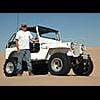ntsqd: good background info on the correct usage of my Jake brake reference. 👍
Engine braking?
#21

Posted 28 June 2021 - 03:14 PM
1996 Dodge Ram 1500 4x4, lightly lifted, ARB bumper/Warn winch, BFG AT/KO2, Snugtop shell. SOLD! But not forgotten!
2002 Chevy 2500HD XC LB 6.0L 4X4, Leer Hi-Rise shell, completely stock...for now!
#22

Posted 29 June 2021 - 12:17 AM
I have a 1993 Dodge Ram W250 with a 1st generation Cummins diesel which has had an exhaust brake on it since around 50,000 miles. The truck has a 5-speed Getrag transmission which has worked well. The truck and engine has 400,000 miles on it. I have never had an engine problem from using the exhaust brake. I have never read of any engine problems caused by using an exhaust brake.
There are two types of engine brakes used on diesel engines - one is a "compression or engine brake" (a.k.a Jake Brake) and the other is an "exhaust brake" (e.g. PAC brake).
The compression brake, opens the exhaust valves to dump engine compression, and would not add any additional stress or heat to the exhaust. When it opens it dumps the compression from the cylinder and the cylinder does not fire so there is no added heat to exhaust. https://youtu.be/HkfjCJClWVA.
An exhaust brake is a device that essentially creates a major restriction in the exhaust system, and creates substantial exhaust back pressure to retard engine speed and offer some supplemental braking. In most cases, an exhaust brake is so effective that it can slow a heavily loaded vehicle on a downgrade without ever applying the vehicle's service brakes. Exhaust brakes are manufactured by many companies. The brakes vary in design, but essentially operate as described above. https://en.wikipedia...i/Exhaust_brake
One perspective is that since the injectors are flowing little or no fuel while the exhaust brake is in use, the engine is effectively acting as an enormous air pump, running relatively low-temperature air into the exhaust. Despite the “blockage” created by the exhaust brake, it is likely cooling the manifold because there is no combustion, especially at the higher RPMs needed for effective braking.
So an "exhaust brake" works by increasing pressure - and a "compression engine brake" works by reducing pressure.
It is my undrrstanding that diesel engines are designed to accomodate either style and you should not need to worry about engine component failure for either style.
Edited by ckent323, 29 June 2021 - 12:18 AM.
1993 Dodge Cummins W-250 Club Cab long bed, 2007 FWC Keystone
#23

Posted 29 June 2021 - 12:46 AM
From what I have seen most of the exhaust brake kits either come with the up-rated exhaust valve springs or strongly recommend their installation.
Where does that road go?
#24

Posted 29 June 2021 - 02:23 AM
Thom,
You are correct that engine exhaust brakes need heavier valve springs to allow the engine to compress the "exhaust gas". My truck (with Cummins 1st gen diesel) has heavier valve springs. I still have the original valves, pistons, rings, turbo and injectors although the injectors have been rebuilt once.
The engine is still running strong and reliably at 400,000 miles. The suspension and some other parts (alternator, water pump, idler pulley) have worn to the point I am replacing things but the engine and drive train are still good. Lots of these trucks out there in hot shot service that have gone 800,000 to 1,000,000+ miles.
Edited by ckent323, 01 July 2021 - 02:16 AM.
1993 Dodge Cummins W-250 Club Cab long bed, 2007 FWC Keystone
#25

Posted 29 June 2021 - 05:24 AM
Looks like I need to make a call to my installer.
Craig K6JGV_________________________ 2004 2500 CTD 4X4 FWC HAWK 1960 CJ5
#26

Posted 29 June 2021 - 06:44 PM
From reading the Pacbrake literature it looks like the 12V Cummins engines need the upgraded exhaust valve springs while the 24V don't. I've never had any problems with the exhaust brake on my stock 24V Cummins.
#27

Posted 29 June 2021 - 11:08 PM
From reading the Pacbrake literature it looks like the 12V Cummins engines need the upgraded exhaust valve springs while the 24V don't. I've never had any problems with the exhaust brake on my stock 24V Cummins.
I have a 2017 CTD. Love the exhaust brake. When I go downhill I hardly ever need to get on the brakes.
#28

Posted 30 June 2021 - 05:51 AM
2006 Duramax here, with a VGT turbo. With a good tow tune, the VGT vanes are used to create an exhaust brake. LOVE it. Cruise control holds speed on most very steep hills.
2012 ATC Puma Shell build - https://www.wanderth...012-puma-build/
Power considerations thread - https://www.wanderth...e-power-scotty/
Building out an electrical system - So, you want to setup a good electrical system in your camper? - Electrical, Charging, Solar, Batteries and Generators - Wander the West
#29

Posted 30 June 2021 - 06:32 PM
Do you make a product for the Ford 7.3L Powerstroke or Navistar International T444E engines?
ANSWER:
No, Jacobs does not offer an exhaust or engine brake for these engines in fact, Navistar and Ford have requested that we do not develop one for these engines.
The primary concern with putting a retarder on these engines is their use of hydraulic lifters. Most engines with hydraulic lifters have fairly low exhaust back pressure limits so the performance of an exhaust brake would not be substantial. More importantly the use of an exhaust brake on an engine with hydraulic lifters can cause engine damage. The problem is that the increased back pressure resulting from the operation of the exhaust brake will cause some degree of valve float. This valve float can cause the hydraulic lifter to re-set with the valve still open (not seated). This phenomenon is known as lifter jacking. Lifter jacking could also result if a traditional engine brake were used on these engines. The results of lifter jacking can be anything from low positive power (because the valves stay open) to engine damage caused by valve to piston contact.
0 user(s) are reading this topic
0 members, 0 guests, 0 anonymous users


















